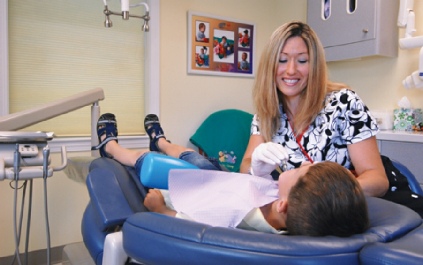


While others in the Bangor area were heading out of town to escape the summer heat, Dr. Sheila Brijade, DDS/MS, was working overtime. The director of pediatric dentistry for Penobscot Community Health Care’s (PCHC) Dental Clinic, Brijade is also the associate director of the Lutheran Medical Center’s Pediatric Residency. While others were hitting the beach, Brijade was preparing for the July arrival of four new pediatric dental residents, which has now doubled the staff of residents at PCHC’s Dental Center.
“Our patients won’t be waiting as long for restorative care,” says Brijade. “June or July, we had a wait time of six to eight weeks for most procedures. With the new residents, we have brought that time down considerably.”
The faster access to pediatric dental care is something that will cause a lot of parents to smile, but perhaps not their children. For some kids, the very thought of a dental appointment can cause real anxiety.
But it doesn’t have to be that way.
There are a few steps that parents and guardians can take to reduce, if not eliminate, that fear of the dentist. Chief among them is to establish what is sometimes referred to as a “dental home,” a place where kids—and parents—feel comfortable and relaxed.
“Going to the dentist is not easy, even for adults,” says Dr. Carey Fister, DMD, a pediatric dentist with her own practice in a bright, cheerful and very welcoming office in Brewer. The overall theme of the space is Disney’s Magic Kingdom, with representations of classic Disney characters popping up in all corners of the tastefully decorated examination rooms. There are even a pair of surprisingly familiar mouse ears on top of the waiting area’s television set. It’s a space clearly designed to put kids at ease, with a philosophy of practice designed to fill parents with confidence.
“We encourage parents to be involved, to be our helpful observers,” says Fister. “Not all dentists feel comfortable having parents in the back room while they carry on treatment, but that’s something we do at our office. A lot of times we have a parent holding a kid’s hand, and I think that helps the child feel safe. It’s also a time for the parent to get to know me and see how I interact with the child and to build trust.”
As is the case with the selection of a pediatrician, the element of trust between parents, doctor, and patient is critical, particularly when you consider how early children should be settling into their dental home.
“The guidelines established by the American Academy of Pediatric Dentistry actually correlate with guidelines put forward by the American Academy of Pediatrics,” explains Brijade. “Your child should begin seeing a dentist within six months of the eruption of the first tooth or by one year of age.”
Why so early? Because even though children will eventually be losing those baby teeth, primary teeth play a critical role in setting the stage for the permanent teeth. It gives parents and dental professionals the opportunity to prevent the kind of issues and experiences that might cause a young person to see dentists in a negative light. It also provides parents with the chance to pick up some useful information.
“When the first visit isn’t based in an emergency, it gives us the time to talk with the parents and educate them about diet, oral hygiene, growth and development, injury prevention, and things they might not know or be thinking about,” says Brijade. “The idea is to prevent things before they happen.
According to Brijade, 14% of Maine kindergarteners have untreated tooth decay. One
percent of kindergarteners need urgent dental care because of pain and infection.
“It’s not uncommon when providing care under general anesthesia to have a child who
needs 16 of their 20 teeth treated,” she says. “Preventing things from getting to
that point allows kids to avoid infections, pain, missed days of school and, in serious
cases, a trip to the emergency room. It’s one of the reasons we’re actually developing,
here at PCHC, a pre-
Without question, parents and guardians play a significant role in their child’s dental health, whether it’s making sure teeth have been brushed, checking labels for the amount of sugar in their juice, or being there to offer their support during a dental appointment. All of which can make the prospect of selecting the right dentist a bit daunting, particularly for those adults for whom a trip to the dentist may not be their favorite thing to do either.
Fister has a short list of what she considers to be key elements when selecting a
pediatric dentist. Among her recommendations is that the office should believe in
and maintain an enthusiastic, compassionate, and team-
Cooperation. Prevention. Education. Trust. A perfect formula for helping even the toughest of patients greet a trip to the dentist with a little confidence, and maybe even a smile.
